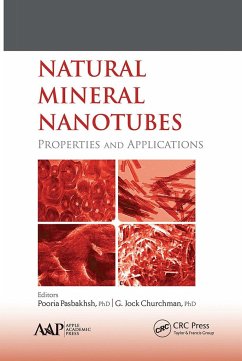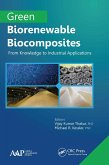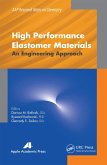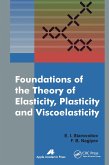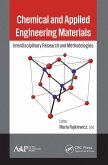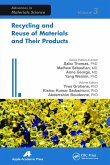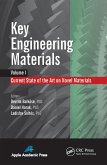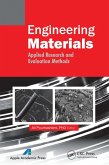Natural Mineral Nanotubes
Properties and Applications
Herausgeber: Pasbakhsh, Pooria; Churchman, G Jock
Natural Mineral Nanotubes
Properties and Applications
Herausgeber: Pasbakhsh, Pooria; Churchman, G Jock
- Broschiertes Buch
- Merkliste
- Auf die Merkliste
- Bewerten Bewerten
- Teilen
- Produkt teilen
- Produkterinnerung
- Produkterinnerung
The book provides a wide introduction on history, minerology, geology, and the characteristics and application of different natural nanotubes. It is the first comprehensive book to discuss natural nanotubes, particularly halloysite nanotubes. The book will be useful mainly for postgraduate students and researchers working on the application of n
Andere Kunden interessierten sich auch für
![Green Biorenewable Biocomposites Green Biorenewable Biocomposites]() Green Biorenewable Biocomposites100,99 €
Green Biorenewable Biocomposites100,99 €![High Performance Elastomer Materials High Performance Elastomer Materials]() High Performance Elastomer Materials100,99 €
High Performance Elastomer Materials100,99 €![Foundations of the Theory of Elasticity, Plasticity, and Viscoelasticity Foundations of the Theory of Elasticity, Plasticity, and Viscoelasticity]() Eduard StarovoitovFoundations of the Theory of Elasticity, Plasticity, and Viscoelasticity99,99 €
Eduard StarovoitovFoundations of the Theory of Elasticity, Plasticity, and Viscoelasticity99,99 €![Chemical and Applied Engineering Materials Chemical and Applied Engineering Materials]() Chemical and Applied Engineering Materials103,99 €
Chemical and Applied Engineering Materials103,99 €![Recycling and Reuse of Materials and Their Products Recycling and Reuse of Materials and Their Products]() Recycling and Reuse of Materials and Their Products103,99 €
Recycling and Reuse of Materials and Their Products103,99 €![Key Engineering Materials, Volume 1 Key Engineering Materials, Volume 1]() Key Engineering Materials, Volume 199,99 €
Key Engineering Materials, Volume 199,99 €![Engineering Materials Engineering Materials]() Engineering Materials100,99 €
Engineering Materials100,99 €-
-
-
The book provides a wide introduction on history, minerology, geology, and the characteristics and application of different natural nanotubes. It is the first comprehensive book to discuss natural nanotubes, particularly halloysite nanotubes. The book will be useful mainly for postgraduate students and researchers working on the application of n
Hinweis: Dieser Artikel kann nur an eine deutsche Lieferadresse ausgeliefert werden.
Hinweis: Dieser Artikel kann nur an eine deutsche Lieferadresse ausgeliefert werden.
Produktdetails
- Produktdetails
- Verlag: CRC Press
- Seitenzahl: 498
- Erscheinungstermin: 31. März 2021
- Englisch
- Abmessung: 234mm x 156mm x 27mm
- Gewicht: 730g
- ISBN-13: 9781774633670
- ISBN-10: 1774633671
- Artikelnr.: 69923262
- Herstellerkennzeichnung
- Libri GmbH
- Europaallee 1
- 36244 Bad Hersfeld
- gpsr@libri.de
- Verlag: CRC Press
- Seitenzahl: 498
- Erscheinungstermin: 31. März 2021
- Englisch
- Abmessung: 234mm x 156mm x 27mm
- Gewicht: 730g
- ISBN-13: 9781774633670
- ISBN-10: 1774633671
- Artikelnr.: 69923262
- Herstellerkennzeichnung
- Libri GmbH
- Europaallee 1
- 36244 Bad Hersfeld
- gpsr@libri.de
Pooria Pasbakhsh, PhD, is a lecturer at the School of Engineering at Monash University in Selangor, Malaysia since 2010 with a specialty in polymer nanocomposites and nanomaterials. He has published several journal and conference papers on characterization and applications of halloysite nanotubes. Since 2007 his research has been supported by the Ministry of Higher Education of Malaysia, Monash University, University of Science Malaysia and Geological Survey of South Australia Resources and Energy Group where he did a short postdoc on characterization of various halloysite nanotubes from different origins at the University of Adelaide in Australia. His current research interests concern the preparation, characterization, and modeling of bionanocomposites for packaging and medical applications. He is a member of the Institute of Materials, Minerals and Mining (UK), and the Australian Clay Minerals Society. G. Jock Churchman, PhD, is adjunct senior lecturer in soils at the University of Adelaide and part-time associate professor at the Centre for Environment Risk Assessment and Remediation at the University of South Australia. He continues trying to understand why halloysite contains interlayer water (his specific PhD thesis topic) while also pursuing many other research topics on clays, especially in soils. He was employed in the New Zealand Soil Bureau, DSIR for 16 years and in CSIRO Division of Soils (later Land and Water) for 14 years, and has held visiting fellowships in soil science at Reading University and the University of Western Australia. He is a former editor (now emeritus) of the journal of Applied Clay Science. In 2005, he completed a BA (Hons) in philosophy from Flinders University of South Australia with a thesis on the philosophical status of soil science. He obtained degrees in chemistry from Otago University in his native New Zealand. He studied the physical chemistry of halloysite for his PhD, under a fellowship from the New Zealand pottery and ceramics industry and carried out research for this industry for a short time before beginning a two-year post-doctoral fellowship in soil science at the University of Wisconsin, USA.
Introduction. Part 1: The Major Nanotubular Minerals and their Structures.
Phyllosilicates Used as Nanotube Substrates in Engineered Materials:
Structures, Chemistries, and Textures. Part 2: The Identification and
Nomenclature of Natural Mineral Nanotubes (A Historical Perspective). The
Identification and Nomenclature of Halloysite (A Historical Perspective).
The Identification and Nomenclature of Sepiolite and Palygorskite (A
Historical Perspective). The Identification and Nomenclature of Chrysotile
(A Historical Perspective). Part 3: Mineralogy, Geology and Occurrence of
Natural Mineral Nanotubes. The Mineralogy, Geology and Occurrences of
Halloysite. The Mineralogy, Geology and Main Occurences of Sepiolite and
Playgorskite Clays. The Mineralogy, Geology and Main Occurrences of
Chrysotile. Part 4: Applications of Natural Mineral Nanotubes in
Nanocomposites. Polymer Nanocomposites Reinforced by Halloysite Nanotubes:
A Review. Part 5: Biopolymer Composites of Natural Mineral Nanotubes and
Their Applications. Bionanocomposites of Sepiolite and Palygorskite and
Their Medical Issues. Biopolymer Nanocomposites: Poly Lactic
Acid/Halloysite Nanotube Composites. Halloysite-Poly(lactic-co-glycolic
acid) Nanocomposites for Biomedical Applications. Current Research on
Chitosan-Halloysite Composites. Part 6: Mechanical Properties of Halloysite
and Other Nanotubes. Measurement of the Elastic Modulus of Halloysite
Nanotubes Using Atomic Force Microscopy. Mechanics of Halloysite Nanotubes.
Part 7: Modification of Natural Mineral Nanotubes. Functionalization and
Compatiblization of Halloysite Nanotubes. Modification of Sepiolite and
Palygorskite Nanotubes and Their Applications. Organopalygorskites
Prepared From Quaternary Ammonium Compounds and Their Environmental Uses.
Surface Modification of Halloysite Nanotubes: Role of External Hydroxyl
Groups. Part 8: Natural Mineral Nanotubes as Nanoreactors used in
Industrial and Agricultural Applications. Halloysite Tubule Nanoreactors in
Industrial and Agricultural Applications. Some Further Industrial,
Environmental and Biomedical Applications of Halloysite Nanotubes.
Nanotubular Minerals as Templates and Nanoreactors. Part 9: Medical and
Health applications of Natural Mineral Nanotubes and Their Health Problems.
Medical and Health Applications of Halloysite Nanotubes. Medical and Health
Applications of Natural Mineral Nanotubes. The Anti-Inflammatory Properties
of Different Naturally-Occurring Halloysites. Health Effects of Carbon
Nanotubes and Some Comparisons with Natural Mineral Nanotubes. Part 10:
Final Remarks. Current Trends in Research and Application of Natural
Mineral Nanotubes. Index.
Phyllosilicates Used as Nanotube Substrates in Engineered Materials:
Structures, Chemistries, and Textures. Part 2: The Identification and
Nomenclature of Natural Mineral Nanotubes (A Historical Perspective). The
Identification and Nomenclature of Halloysite (A Historical Perspective).
The Identification and Nomenclature of Sepiolite and Palygorskite (A
Historical Perspective). The Identification and Nomenclature of Chrysotile
(A Historical Perspective). Part 3: Mineralogy, Geology and Occurrence of
Natural Mineral Nanotubes. The Mineralogy, Geology and Occurrences of
Halloysite. The Mineralogy, Geology and Main Occurences of Sepiolite and
Playgorskite Clays. The Mineralogy, Geology and Main Occurrences of
Chrysotile. Part 4: Applications of Natural Mineral Nanotubes in
Nanocomposites. Polymer Nanocomposites Reinforced by Halloysite Nanotubes:
A Review. Part 5: Biopolymer Composites of Natural Mineral Nanotubes and
Their Applications. Bionanocomposites of Sepiolite and Palygorskite and
Their Medical Issues. Biopolymer Nanocomposites: Poly Lactic
Acid/Halloysite Nanotube Composites. Halloysite-Poly(lactic-co-glycolic
acid) Nanocomposites for Biomedical Applications. Current Research on
Chitosan-Halloysite Composites. Part 6: Mechanical Properties of Halloysite
and Other Nanotubes. Measurement of the Elastic Modulus of Halloysite
Nanotubes Using Atomic Force Microscopy. Mechanics of Halloysite Nanotubes.
Part 7: Modification of Natural Mineral Nanotubes. Functionalization and
Compatiblization of Halloysite Nanotubes. Modification of Sepiolite and
Palygorskite Nanotubes and Their Applications. Organopalygorskites
Prepared From Quaternary Ammonium Compounds and Their Environmental Uses.
Surface Modification of Halloysite Nanotubes: Role of External Hydroxyl
Groups. Part 8: Natural Mineral Nanotubes as Nanoreactors used in
Industrial and Agricultural Applications. Halloysite Tubule Nanoreactors in
Industrial and Agricultural Applications. Some Further Industrial,
Environmental and Biomedical Applications of Halloysite Nanotubes.
Nanotubular Minerals as Templates and Nanoreactors. Part 9: Medical and
Health applications of Natural Mineral Nanotubes and Their Health Problems.
Medical and Health Applications of Halloysite Nanotubes. Medical and Health
Applications of Natural Mineral Nanotubes. The Anti-Inflammatory Properties
of Different Naturally-Occurring Halloysites. Health Effects of Carbon
Nanotubes and Some Comparisons with Natural Mineral Nanotubes. Part 10:
Final Remarks. Current Trends in Research and Application of Natural
Mineral Nanotubes. Index.
Introduction. Part 1: The Major Nanotubular Minerals and their Structures.
Phyllosilicates Used as Nanotube Substrates in Engineered Materials:
Structures, Chemistries, and Textures. Part 2: The Identification and
Nomenclature of Natural Mineral Nanotubes (A Historical Perspective). The
Identification and Nomenclature of Halloysite (A Historical Perspective).
The Identification and Nomenclature of Sepiolite and Palygorskite (A
Historical Perspective). The Identification and Nomenclature of Chrysotile
(A Historical Perspective). Part 3: Mineralogy, Geology and Occurrence of
Natural Mineral Nanotubes. The Mineralogy, Geology and Occurrences of
Halloysite. The Mineralogy, Geology and Main Occurences of Sepiolite and
Playgorskite Clays. The Mineralogy, Geology and Main Occurrences of
Chrysotile. Part 4: Applications of Natural Mineral Nanotubes in
Nanocomposites. Polymer Nanocomposites Reinforced by Halloysite Nanotubes:
A Review. Part 5: Biopolymer Composites of Natural Mineral Nanotubes and
Their Applications. Bionanocomposites of Sepiolite and Palygorskite and
Their Medical Issues. Biopolymer Nanocomposites: Poly Lactic
Acid/Halloysite Nanotube Composites. Halloysite-Poly(lactic-co-glycolic
acid) Nanocomposites for Biomedical Applications. Current Research on
Chitosan-Halloysite Composites. Part 6: Mechanical Properties of Halloysite
and Other Nanotubes. Measurement of the Elastic Modulus of Halloysite
Nanotubes Using Atomic Force Microscopy. Mechanics of Halloysite Nanotubes.
Part 7: Modification of Natural Mineral Nanotubes. Functionalization and
Compatiblization of Halloysite Nanotubes. Modification of Sepiolite and
Palygorskite Nanotubes and Their Applications. Organopalygorskites
Prepared From Quaternary Ammonium Compounds and Their Environmental Uses.
Surface Modification of Halloysite Nanotubes: Role of External Hydroxyl
Groups. Part 8: Natural Mineral Nanotubes as Nanoreactors used in
Industrial and Agricultural Applications. Halloysite Tubule Nanoreactors in
Industrial and Agricultural Applications. Some Further Industrial,
Environmental and Biomedical Applications of Halloysite Nanotubes.
Nanotubular Minerals as Templates and Nanoreactors. Part 9: Medical and
Health applications of Natural Mineral Nanotubes and Their Health Problems.
Medical and Health Applications of Halloysite Nanotubes. Medical and Health
Applications of Natural Mineral Nanotubes. The Anti-Inflammatory Properties
of Different Naturally-Occurring Halloysites. Health Effects of Carbon
Nanotubes and Some Comparisons with Natural Mineral Nanotubes. Part 10:
Final Remarks. Current Trends in Research and Application of Natural
Mineral Nanotubes. Index.
Phyllosilicates Used as Nanotube Substrates in Engineered Materials:
Structures, Chemistries, and Textures. Part 2: The Identification and
Nomenclature of Natural Mineral Nanotubes (A Historical Perspective). The
Identification and Nomenclature of Halloysite (A Historical Perspective).
The Identification and Nomenclature of Sepiolite and Palygorskite (A
Historical Perspective). The Identification and Nomenclature of Chrysotile
(A Historical Perspective). Part 3: Mineralogy, Geology and Occurrence of
Natural Mineral Nanotubes. The Mineralogy, Geology and Occurrences of
Halloysite. The Mineralogy, Geology and Main Occurences of Sepiolite and
Playgorskite Clays. The Mineralogy, Geology and Main Occurrences of
Chrysotile. Part 4: Applications of Natural Mineral Nanotubes in
Nanocomposites. Polymer Nanocomposites Reinforced by Halloysite Nanotubes:
A Review. Part 5: Biopolymer Composites of Natural Mineral Nanotubes and
Their Applications. Bionanocomposites of Sepiolite and Palygorskite and
Their Medical Issues. Biopolymer Nanocomposites: Poly Lactic
Acid/Halloysite Nanotube Composites. Halloysite-Poly(lactic-co-glycolic
acid) Nanocomposites for Biomedical Applications. Current Research on
Chitosan-Halloysite Composites. Part 6: Mechanical Properties of Halloysite
and Other Nanotubes. Measurement of the Elastic Modulus of Halloysite
Nanotubes Using Atomic Force Microscopy. Mechanics of Halloysite Nanotubes.
Part 7: Modification of Natural Mineral Nanotubes. Functionalization and
Compatiblization of Halloysite Nanotubes. Modification of Sepiolite and
Palygorskite Nanotubes and Their Applications. Organopalygorskites
Prepared From Quaternary Ammonium Compounds and Their Environmental Uses.
Surface Modification of Halloysite Nanotubes: Role of External Hydroxyl
Groups. Part 8: Natural Mineral Nanotubes as Nanoreactors used in
Industrial and Agricultural Applications. Halloysite Tubule Nanoreactors in
Industrial and Agricultural Applications. Some Further Industrial,
Environmental and Biomedical Applications of Halloysite Nanotubes.
Nanotubular Minerals as Templates and Nanoreactors. Part 9: Medical and
Health applications of Natural Mineral Nanotubes and Their Health Problems.
Medical and Health Applications of Halloysite Nanotubes. Medical and Health
Applications of Natural Mineral Nanotubes. The Anti-Inflammatory Properties
of Different Naturally-Occurring Halloysites. Health Effects of Carbon
Nanotubes and Some Comparisons with Natural Mineral Nanotubes. Part 10:
Final Remarks. Current Trends in Research and Application of Natural
Mineral Nanotubes. Index.

